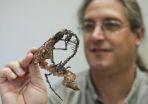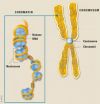(Press-News.org) An ongoing Phase-II trial investigating a new, targeted therapy for metastatic urothelial cancer has generated promising early results, Italian researchers reported at the 35th Congress of the European Society for Medical Oncology (ESMO) in Milan, Italy.
Urothelial cancers affect the tissue lining the inner surfaces of the bladder and other parts of the urinary system. In cases of metastatic disease, median survival is approximately 12-15 months and there is a 10-15% chance of prolonging it by the use of standard chemotherapy regimens, particularly in otherwise healthy patients with good prognostic factors.
Those whose cancers relapse or do not respond to upfront therapy currently have few second-line treatment options and palliative care is the option in the majority of cases.
Dr Andrea Necchi from Fondazione IRCCS Istituto Nazionale dei Tumori of Milan and colleagues have begun a Phase-II trial using pazopanib in this setting. Pazopanib is a selective inhibitor of several signaling pathways that contribute to tumor growth and the development of new cancer-related blood vessels (angiogenesis).
So far, the researchers have enrolled 18 patients of a total of 41 planned. Each participant had metastatic urothelial cancer that had already failed to respond to at least one prior chemotherapy regimen. This means that investigators treated many patients who had already failed more than two chemotherapy regimens. Patients were administered 800mg of the drug once daily until their disease progressed or they experienced unacceptable toxicity.
"Thus far, four patients have seen their tumors shrink but, much more interestingly, the great majority of the patients --twelve out of eighteen-- saw their metastases begin to die," Dr Necchi said.
The death of these metastatic tumors, described formally as 'necrotic evolution', was observed by the researchers on monthly computed tomography and positron emission tomography scans.
"Considering this drug partly acts to prevent tumors recruiting the blood supplies they need to live and grow, necrotic evolution of metastases is not completely surprising," Dr Necchi said. "But this is the first time we have seen this phenomenon in so many cases of urothelial cancer. The challenge is to translate this kind of activity into a survival advantage."
"Of course we are only at the first step of this Phase-II trial and caution is needed when interpreting results," Dr Necchi said. "A longer follow-up time and greater sample size are needed before we can declare the study a success. However, for the first time in this disease we are generating interest among investigators and, particularly, of pharmaceutical industry."
The current trial is independent of the pharmaceutical industry, Dr Necchi noted. The sponsor is Fondazione IRCCS Istituto Nazionale dei Tumori of Milan. "The study shows that it is possible in Europe to promote independent research that focuses attention on challenging problematic matters, such as salvage therapy in urothelial cancer."
"These preliminary results underline the value of angiogenesis as a target in bladder cancer," commented Dr Joaquim Bellmunt, Section Chief, Solid Tumor Oncology at Hospital del Mar in Barcelona, Spain. "They add to results other groups have published recently using similar drugs to treat bladder cancer."
INFORMATION: END
The results of a large Phase-III clinical trial have shown that the drug everolimus delays tumor progression in patients with a hard-to-treat group of rare cancers that affect particular hormone-producing cells.
At the 35th Congress of the European Society for Medical Oncology (ESMO), Dr Marianne Pavel from Charité University in Berlin, Germany reported that everolimus improved progression-free survival by 5.1 months in patients with advanced neuroendocrine tumors.
Neuroendocrine tumors are slow-growing malignancies that originate from cells of the body's neuroendocrine ...
A new class of compounds identified by researchers at Emory University School of Medicine could be developed into drugs for the treatment of schizophrenia. The compounds enhance signaling by molecules in the brain called NMDA receptors, which scientists believe are functioning at low levels in people with schizophrenia.
Led by Stephen Traynelis, PhD, professor of pharmacology, a team of Emory researchers sifted through thousands of chemicals and found one, called CIQ, which could selectively enhance the function of certain NMDA receptors without affecting others.
The ...
Iowa City, IA—October 11, 2010— A new study published in Applied Cognitive Psychology finds that college-aged men are very likely to remember a woman's initial sexual interest (attraction or rejection), especially when the woman in question is thought to be attractive, is dressed more provocatively, and expresses positive sexual interest.
In the study the men were shown full-body photographs of college-aged women who expressed cues of sexual interest or rejection. The participating males represented mixed sexual histories, and a capacity for varying degrees of sexually ...
GAINESVILLE, Fla. --- University of Florida researchers presenting new fossil evidence of an exceptionally well-preserved 55-million-year-old North American mammal have found it shares a common ancestor with rodents and primates, including humans.The study published today in the online edition of the Zoological Journal of the Linnean Society, describes the cranial anatomy of the extinct mammal, Labidolemur kayi.
High resolution CT scans of the specimens allowed researchers to study minute details in the skull, including bone structures smaller than one-tenth of a millimeter. ...
The genetic inherited material DNA was long viewed as the sole bearer of hereditary information. The function of its packaging proteins, the histones, was believed to be exclusively structural. Additional genetic information can be stored, however, and passed on to subsequent generations through chemical changes in the DNA or histones. Scientists from the Max Planck Institute for Biophysical Chemistry in Göttingen have succeeded in creating an experimental system for testing the function of such chemical histone modifications and their influence on the organism. Chemical ...
More brilliant X-rays, more cost-effective methods for developing new energy sources and advanced manufacturing processes are just some of the benefits which may come from a novel technology, proven at the theoretical level by a consortium of British and European laser scientists. The research, led by scientists at the Science and Technology Facilities Council's Central Laser Facility is published in this week's edition of Nature Physics (October 10 2010).
A team of scientists from the Instituto Superior Tecnico in Lisbon, Imperial College London, and the Universities ...
A University of Colorado at Boulder space dust counter designed, tested and operated by students that is flying aboard NASA's New Horizons mission to Pluto now holds the record for the most distant working dust detector ever to travel through space.
The instrument on the New Horizons mission -- officially named the Venetia Burney Student Dust Counter, or SDC, after an 11-year-old English girl who named Pluto more than 75 years ago -- reached a distance of 1.67 billion miles from Earth on Oct. 10. Designed by a student team from CU-Boulder's Laboratory for Atmospheric ...
Providence, RI---It was a mathematician, Joseph Fourier (1768-1830),
who coined the term "greenhouse effect". That this term, so commonly
used today to describe human effects on the global climate, originated
with a mathematician points to the insights that mathematics can offer
into environmental problems. Three articles in the November 2010
issue of the Notices of the American Mathematical Society examine ways
in which mathematics can contribute to understanding environmental and
ecological issues.
"Earthquakes and Weatherquakes: Mathematics and Climate Change", ...
Prenatal treatment of congenital toxoplasmosis with antibiotics might substantially reduce the proportion of infected fetuses that develop serious neurological sequelae (brain damage, epilepsy, deafness, blindness, or developmental problems) or die, and could be particularly effective in fetuses whose mothers acquired Toxoplasma gondii, the parasite that causes toxoplasmosis, during the first third of pregnancy. These are the findings of an observational study by Ruth Gilbert from the UCL Institute of Child Health, London, UK, and colleagues and published in this week's ...
Wayne Hall, Rebecca Mathews and Katherine Morley discuss the limitations of genomic risk prediction for population-level preventive health care. Whilst genome-wide association studies and genomic sequencing have the potential to reveal susceptibilities to disease, they sound a note of caution about widescale implementation of such tests. In particular they point out that before genomic information is used in public health screening, it must first be shown that it predicts disease risk better than phenotypic information. They go on to point out that before genomic information ...



